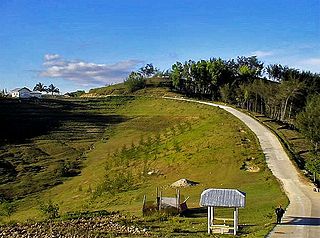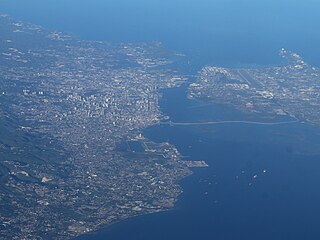
Cebu City, officially the City of Cebu, is a 1st class highly urbanized city in the Central Visayas region of the Philippines. According to the 2020 census, it has a population of 964,169 people, making it the sixth-most populated city in the nation and the most populous in the Visayas and in Central Visayas Region.

Alcoy, officially the Municipality of Alcoy, is a 5th class municipality in the province of Cebu, Philippines. According to the 2020 census, it has a population of 19,186 people.

The Glenmore Reservoir is a large reservoir on the Elbow River in the southwest quadrant of Calgary, Alberta. It is controlled by the Glenmore Dam, a concrete gravity dam on the Elbow River. The Glenmore Reservoir is a primary source of drinking water to the city of Calgary. Built in 1932, with a cost of $3.8 million, the dam controls the downstream flow of the Elbow River, thus allowing the city to develop property near the river's banks with less risk of flooding.

Metropolitan Cebu, or simply Metro Cebu,, is the main urban center of the province of Cebu in the Philippines. Metro Cebu is located along the central eastern portion of the island including the nearby island of Mactan. It accounts for 19.9 percent of the land area and 61.5 percent of the population of the entire province of Cebu.

Manila Water Company, Inc. has the exclusive right to provide water and used water (wastewater) services to over six million people in the East Zone of Metro Manila. It is a subsidiary of Enrique Razon's Trident Water Holdings Company, Inc., who acquired stakes from the country's oldest conglomerate, Ayala Corporation, in 2024.

Michael Lopez Rama is a Filipino politician serving as Mayor of Cebu City since 2021, a position he previously held from 2010 to 2016. He served as the Vice Mayor of Cebu City from 2001 to 2010 and from 2019 to 2021, and was a member of the Cebu City Council from 1992 to 2001. He was elected the National President of the League of Cities of the Philippines in 2022.

The La Mesa Dam and Reservoir is an earth dam in Quezon City, Philippines. Its reservoir can hold up to 50.5 million cubic meters, occupying an area of 27 square kilometers (10 sq mi). It is part of the Angat-Ipo-La Mesa water system, which supplies most of the water in Metro Manila.

The Central Cebu Protected Landscape (CCPL) is a protected area located in the mountains and drainage basins of central Cebu in the Philippines.

The Dahla Dam, also known as Arghandab Dam and Kasa, is located in the Shah Wali Kot District of Kandahar Province in Afghanistan, approximately 40 km (25 mi) northeast of the provincial capital Kandahar. Its name derives from Dahla, which is the historical name of the area where the dam was built. It is the second largest dam in Afghanistan after the Kajaki Dam in neighboring Helmand Province. In 2019, the Afghan government planned to spend $450 million in upgrading the dam. The project includes raising the dam's walls by around 13 meters so the reservoir could hold nearly a billion cubic meters of fresh water and installing three turbines to produce 22 megawatts (MW) of electricity.

The Manggahan Floodway is an artificially constructed waterway in Metro Manila, Philippines. The floodway was built in 1986, with the cost of 1.1 billion pesos, in order to reduce flooding along the Pasig River during the rainy season, by diverting the peak water flows of the Marikina River to Laguna de Bay, which serves as a temporary reservoir. In case the water level on the lake is higher than the Marikina River, the floodway can also reverse the flow.

Angat Dam is a concrete water reservoir embankment hydroelectric dam in the Philippines that supplies Metro Manila and nearby provinces with water. It was a part of the Angat-Ipo-La Mesa water system. The reservoir supplies about 90 percent of raw water requirements for Metro Manila through the facilities of the Metropolitan Waterworks and Sewerage System and it irrigates about 28,000 hectares of farmland in the provinces of Bulacan and Pampanga.

Zengwen Dam, also spelled Tsengwen Dam, is a major earthen dam in Dapu Township, Chiayi County, Taiwan on the Zengwen River. It is the third tallest dam in Taiwan, and forms Zengwen Reservoir (曾文水庫), the biggest reservoir in Taiwan by volume. The dam stores water for irrigation of the Chianan Plain, Taiwan's most productive agricultural region, and provides flood control along the Zengwen River which flows through Tainan City. The dam supports a 50 megawatt hydroelectric power station.
Several bulk water supply projects on the upper portion of the Kaliwa River Watershed have been proposed by the Philippine Government since the 1970s, with the intent of relieving Metro Manila of its overdependence on the water supplied by Angat Dam. Most of these have focused on a particular site in Barangay Laiban in Tanay, Rizal, on the upper portion of the Kaliwa River Watershed to which the Laiban Dam belongs, and the projects have thus often been referred to as Laiban dam or Kaliwa dam, although multiple projects have been referred to using either name.

The South Road Properties (SRP), also known as the South Reclamation Project, is a 300 ha reclamation area in Cebu City, Philippines. The area, which is reclaimed from Mactan Channel, is located off the coast of the southern district of Cebu City, near Barangays Mambaling, Inayawan, and Pasil. It spans from the shore of mainland Cebu to Kawit Point. An island-type reclaimed area, it is connected with mainland Cebu by the Cebu South Coastal Road and the Mambaling Access Road. Through the Cebu–Cordova Link Expressway, the SRP is also connected by land to Cordova and the island of Mactan.

The Cebu City Council is the legislature of Cebu City, Philippines. The legislative body is composed of 18 councilors, with 16 councilors elected from Cebu City's two councilor districts and two elected from the ranks of barangay (neighborhood) chairmen and the Sangguniang Kabataan. The council's presiding officer is the vice-mayor. The council is responsible for creating laws and ordinances under the jurisdiction of Cebu City. Although the mayor can veto proposed bills, the council can override the veto with a two-thirds supermajority.

Local elections were held in Cebu City on May 13, 2019 within the Philippine general election. Registered voters of the city elected candidates for the following elective local posts: mayor, vice mayor, district representative, and eight councilors at-large for each district. There are two legislative districts in the city.

Edgardo Colina Labella was a Filipino politician and lawyer who served as the mayor of Cebu City from 2019 until his death in 2021. Prior to becoming mayor, he was the city's vice mayor from 2013 to 2019 and was a member of the Cebu City Council from 1998 to 2001 and again from 2004 to 2013.
Transportation within Cebu City is mainly land-based with most parts of the city accessible by road. There is no existing mass transit but construction is currently being undertaken on the Cebu Bus Rapid Transit System as well as an existing proposal for a Cebu Monorail, both of which will be crucial in solving the city's worsening traffic congestion, as existing transportation modes will soon become insufficient to move residents around the city if the local government fails to urgently implement infrastructure projects and measures to address the issue.

Local elections were held in Cebu City on May 9, 2022 within the Philippine general election. Registered voters of the city will be electing candidates for the following elective local posts: mayor, vice mayor, district representative, and eight councilors at-large for each district. There are two legislative districts in the city.

Natalio Bacalso Avenue, also known as Cebu South Road and informally as Cebu South Expressway, is a highway from Cebu to Samboan in Cebu, Philippines. It is currently Cebu's longest road, stretching around 140 kilometers (87 mi). It is named after Natalio Bacalso, a Cebuano writer.



















